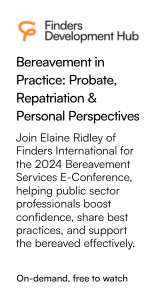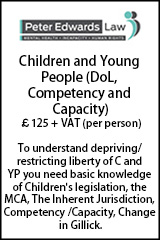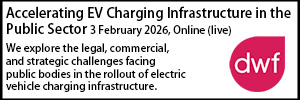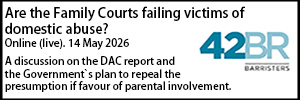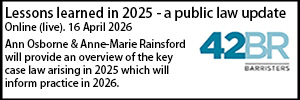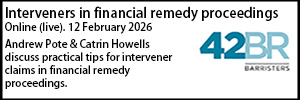Judges reject appeal against local authority decision not to determine appellant as “child in need” when he was 16
- Details
The Court of Appeal has rejected a young man’s appeal against a local authority’s failure to determine him to be a “child in need” within the meaning of s.17 of the Children Act 1989, when carrying out a child and family assessment in 2021.
In TW, R (on behalf of) v Essex County Council [2025] EWCA Civ 4, the appellant, TW, argued that had he been so determined at age 16, he would subsequently have been treated as a “former relevant child” and received the benefits from that status.
Rejecting the appeal, Lord Justice Baker concluded that the local authority’s decision was reached rationally after a “careful assessment” and was “plainly in line with national guidance”.
The appellant, TW, was born in 2004. When he was a young child, his parents’ relationship broke down and thereafter he lived with his mother and her new partner.
In 2018, when TW was 14 years old, his mother died. Initially, he continued to live with his stepfather.
In early 2021, however, when TW was 16, his relationship with his stepfather broke down and, following an altercation to which the police were called, TW left the property.
Subsequently, TW divided his time staying some nights with his elder brother and his girlfriend and other nights with his biological father. Neither property contained a spare bedroom so in both properties TW slept on a sofa.
Following the incident at the stepfather’s home, the police referred TW to the local authority. A social worker, SM, was assigned to carry out a child and family assessment which she completed on 27 May 2021.
In the concluding section of her assessment, under the heading “What are we worried about?”, SM noted that TW “does not have a stable place to live in the long term”; that his relationship with his stepfather had broken down; that he had not processed the loss and trauma of losing his mother; that he was not in education, training or employment, and that he had a limited support network.
In light of her conclusions, the social worker recommended that TW be supported to access housing through Essex Young People's Partnership (EYPP), with “additional support” from Family Solutions.
Baker LJ noted that Family Solutions is the local authority’s scheme for providing support under s.10 of the Children’s Act 2004.
In June 2021, TW moved into a property run by EYPP, where he stayed for just over a year.
In May 2022, shortly before his 18th birthday, TW was served with a notice to quit the property and moved out in July. Family Solutions closed his case.
He resumed sleeping on sofas at his father’s flat and other properties occupied by friends.
Baker LJ noted: “In his statement, TW described a number of personal difficulties he experienced during this period, in particular with his mental health. It is his case that he was badly let down by the local authority who, he maintains, failed to give him the support he needed during his teenage years.”
In February 2023, TW issued a claim for judicial review on the following grounds:
- The local authority was acting unlawfully by refusing to accept that he was a former relevant child.
- As a result of the local authority’s unlawful refusal to accept that TW was a former relevant child, it was unlawfully failing to comply with its duties under ss.23C-23E of the Children Act 1989.
- The local authority was operating an unlawful policy and/or practice whereby accommodation made available to young people pursuant to its contractual arrangements with Nacro, under a scheme originally entitled EYPP but now known as Essex NEST, is held not to be provided or available under s.20 of the 1989 Act.
- In the alternative to Grounds 1 and 2, if it is found that the local authority has acted unlawfully in respect of TW but that for any reason TW was not a former relevant child as a matter of law, then the local authority’s refusal to exercise its discretion to treat him as a former relevant child was unlawful.
Judgment was handed down in February 2024. The appellant was granted permission on all grounds but ultimately his substantive claim for judicial review was dismissed.
Dealing with the first two grounds of the claim, Upper Tribunal Judge Ward (“the judge”) identified two issues:
a. Was the Defendant’s decision that the Claimant was not a child in need lawful?
b. Did the Claimant reject accommodation under section 20 of the 1989 Act and/or was the Defendant lawfully entitled to conclude that he had done so?”
At paragraphs 71-2, he made the following observation on the interpretation of s.17(10):
“The questions posed by the statute are whether the child is “unlikely” to achieve or maintain a “reasonable” standard without the provision of the relevant services. That involves deciding whether the negative “unlikely” is made out. It is only a “reasonable” standard which has to be achieved. Both suggest that the test under section 17(10)(a) will not lightly be met. Further, weight has to be given to the final words of section 17(10)(a). As the Divisional Court said in R (VC) v Newcastle City Council [2011] EWHC 2673 (Admin) at [29]:
“The duties of a local authority do not extend to all children who might be said to be “in need”. Apart from a child who is ‘disabled’ in the statutory sense, they apply only to a child who ‘without the provision for him of services by [the] local authority’ will fall within one or other of the statutory criteria.”
The judge also drew on a passage from paragraph 3.2 of the National Guidance cited by counsel for the local authority:
“If the young person is at risk of becoming homeless in the future, for example because of conflict within the family home, it will be for children’s services to determine what support is required depending on the circumstances and the needs of the young person and their family. Where there is no immediate threat of homelessness intervention may be more appropriately led by early help services, whereas, if there is an imminent threat of homelessness or if the young person is actually homeless, a child in need assessment must be carried out and the child accommodated under section 20.”
At paragraph 85, he added: “Whether in the terms of para.3.2 of the National Guidance, the Claimant was “at risk of becoming homeless in the future” with “no immediate threat of homelessness”, or there was “an imminent threat of homelessness” or he was “actually homeless” was a matter for the Defendant (subject to public law).”
This led Judge Ward to the following evaluation: “The Claimant in each of the locations had a bare licence. Effectively he was dependent on his father and on his brother/brother’s girlfriend not to terminate the corresponding licence. The Claimant was likely to become homeless at some point between the date of the assessment and turning 18 in May 2022 and the question was, when. The licences were informal and dependent for their maintenance on considerations of familial love and support and on the ability of those concerned to get on. These were pre-eminently issues for a professional social worker who had taken steps adequately to inform themselves. As the National Guidance para.3.16 puts it, “Determining who is in need and the extent of any needs requires professional judgment by social workers…”. SM had met those concerned and had heard from them and had had the opportunity to witness their interactions with the Claimant and was in consequence well-placed to assess these issues on behalf of the Defendant in the exercise of her professional judgment. I consider that, in the light of SM’s evidence, the Defendant was entitled to conclude that the Claimant was not homeless and therefore that was not a factor which would support a conclusion that the Claimant was a “child in need”.”
TW submitted the following grounds of appeal against the judge’s conclusion:
- In respect of grounds 1 and 2 before the judge, he was wrong in law and/or in fact to conclude that the local authority’s May 2021 decision that TW was not a child in need was lawful.
- For the reasons set out under grounds 1 and 2 before the judge, TW does have standing in respect of ground 3 and the judge’s conclusion that he did not was wrong.
- The judge was wrong in law and/or in fact to find that EYPP / Essex NEST was not provided by the local authority pursuant to s.20.
- The judge was wrong to dismiss ground 4 in circumstances in which that was predicated on his conclusions on grounds 1 to 3.
Outlining the submissions of the parties, Baker LJ said counsel for the appellant submitted that the local authority’s decision that TW was not a child in need was “irrational” because any consideration of whether the child was a child in need involved “consideration of the longer term, not merely his immediate circumstances”.
Mathew Purchase KC, on behalf of TW, relied on evidence within the assessment that TW’s current accommodation with his father and brother was not a long-term option and that his mental health problems were both serious and related to his housing situation.
He pointed to the observations in the assessment that TW had neglected his health since his mother’s death and did not feel able to process the trauma of losing his mother until he had a stable and safe place to live.
Given his vulnerabilities, it was “not open” to the local authority to conclude that his current accommodation arrangements, moving from one sofa to another in two different properties, were suitable.
Discussing the case, Baker LJ said: “In my view the judge’s conclusion on the rationality issue under grounds 1 and 2 is unassailable. As he observed, “the bar is set high and the challenge does not clear it.”
He added: “The principle that the evaluation of whether a child is a child in need is a matter for professional judgment by the local authority is reflected in the National Guidance. Paragraph 3.16 provides:
“Determining who is in need and the extent of any needs requires professional judgment by social workers, informed by consultation with other professionals familiar with the circumstances of the individual young person and their family.”
“That was precisely what happened in the present case. On the evidence put before him, the judge concluded:
“SM had met those concerned and had heard from them and had had the opportunity to witness their interactions with the Claimant and was in consequence well-placed to assess these issues on behalf of the Defendant in the exercise of her professional judgment.”
Having considered SM’s assessment, Baker LJ agreed that she had carried out a “thorough analysis” of all issues relevant to determining whether TW was a child in need.
Baker LJ continued: “In this case, TW had been excluded from his stepfather’s home. Although he was not sleeping with friends or in a car, he was dividing his time between two properties occupied by family members and sleeping on a sofa in each property. Those circumstances might have led the local authority to conclude that he was a child in need, particularly given his other vulnerabilities. But after SM’s careful analysis, the manager concluded that he was not a child in need, for the reasons set out above. That conclusion was one which the manager was entitled to reach on the basis of SM’s assessment. It was not irrational.”
Dismissing the appeal, Lord Justice Baker concluded: "From TW’s point of view, it is of course very unfortunate that he was not designated a child in need because he is not entitled to be treated as a “former relevant child” and receive the benefits which would flow from that status. As Baroness Hale warned in R (M) v Hammersmith and Fulham LBC, there is plainly a risk that some cash-strapped local authorities may seek to avoid their responsibilities under Part III of the Act. But there is no basis for thinking that this local authority has taken that course in this case. Its decision was reached rationally after a careful assessment and was plainly in line with national guidance.”
Lord Justice Lewis and Lord Justice Jeremy Baker agreed.
Lottie Winson
























